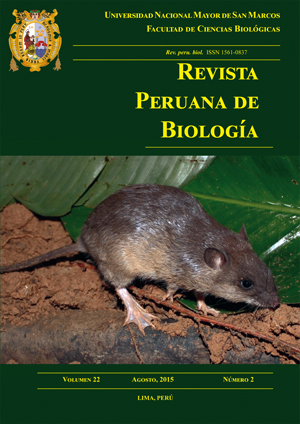An annotated checklist of trees and relatives in tropical montane forests from southeast Peru: the importance of continue collecting
DOI:
https://doi.org/10.15381/rpb.v22i2.11351Keywords:
Andes, altitudinal range, climate change, species distribution, tree diversity, tropical montane forest.Abstract
The tropical Andes and adjacent Amazon are Earth’s highest biodiversity hotspot. Manu National Park in southeastern Peru encompasses an entire watershed, ranging from Andean highlands to Amazonian lowlands, and is a megadiverse landscape on the Andes to Amazon transition. Here we present an annotated checklist of trees and related species is along an elevation gradient in the Manu Biosphere Reserve that runs from sub-montane forests at 800 m elevation up to the tree line at 3625 m. Based on a network of 21 1-hectare permanent tree plots and botanical explorations, the floristic information is systematized by elevation ranges, geographical distribution and endemism. These preliminary results show 1108 species. Of these, 43% are new records for the region of Cusco, 15 species are new records for the Peruvian flora, 40 species are endemics for Peru, and 30 are potential new species for science. Another 39.7% are identified to genus or family level and remain morphospecies. Additionally, we show altitudinal range expansion for 45.2% of identified species (302 species). These results were found in a transect of plots spanning only 20 km of geographic distance, and are a sample of the high tree diversity in these mountainous ecosystems. The data show how poorly collected and understudied these ecosystems are. Basic floristic studies and collections are imperative for a better understanding of species distribution and function of ecosystems, and the basic biodiversity of the tropical Andes. They will also help to answer a major, unresolved question in modern global ecology of how tropical forests will respond to global climate change.Downloads
Downloads
Published
Issue
Section
License
Copyright (c) 2015 William Farfan-Rios, Karina Garcia-Cabrera, Norma Salinas, Mireya N. Raurau-Quisiyupanqui, Miles R. Silman

This work is licensed under a Creative Commons Attribution-NonCommercial-ShareAlike 4.0 International License.
AUTHORS RETAIN THEIR RIGHTS:
a. Authors retain their trade mark rights and patent, and also on any process or procedure described in the article.
b. Authors retain their right to share, copy, distribute, perform and publicly communicate their article (eg, to place their article in an institutional repository or publish it in a book), with an acknowledgment of its initial publication in the Revista Peruana de Biologia.
c. Authors retain theirs right to make a subsequent publication of their work, to use the article or any part thereof (eg a compilation of his papers, lecture notes, thesis, or a book), always indicating its initial publication in the Revista Peruana de Biologia (the originator of the work, journal, volume, number and date).


















